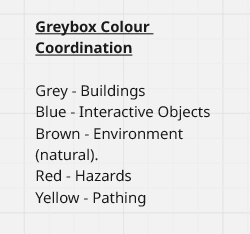Blastpath - Level Breakdown
Level Designer
Overview
Blastpath is a hack-and-slash movement game where players use explosives and momentum to traverse hazardous environments and combat mechanical enemies. This project was part of a final university module, working with a team of nine on a game brief provided by Sumo Digital. We received biweekly feedback from Sumo, helping us iterate and improve the game.
Highlight of my contributions:
-
Tutorial Design & Integration: Wrote and implemented tutorial scripts to teach core mechanics step-by-step, embedding them naturally into gameplay.
-
Level Design: Created greybox layouts using Unity’s CSG tools for rapid iteration; balanced combat arenas with exploratory sections to maintain flow variety.
-
Technical Implementation: Developed functional scripts for basic player interactions and integrated environment art after testing and refinement.
-
Iteration Process: Incorporated bi-weekly feedback from industry clients at Sumo Digital, applying targeted adjustments to improve clarity, pacing, and player engagement.
Design Objectives
The project was developed based on the brief given by Sumo Digital based on Mihaly Csikszentmihalyi's Flow Theory. The game had to induce player's into a flow state with the target market being casual.
I was tasked with the creation of the tutorial level and a main level. Given the design of the game and the brief, my levels needed to achieve:
1. The level must be easy to interpret and should follow a linear path to allow players of all skill level to navigate the space.
2. The level must be balanced with a blend of challenge and reward in order to induce and keep the flow state.
3. The levels must support the movement mechanics of the game, using space to amplify the game feel and navigation.
Research
I started by looking into Aztec architecture, since the theme of the game was Aztec Steampunk. I focused on the shapes and geometry of Aztec buildings, like pyramids and bold patterns, and thought about how these could influence player movement through the level.
Next, I researched movement-based games to see how their layouts were designed. Most were fairly linear, but I noted how they used their structure to guide players while still keeping gameplay fun and fluid.
I also looked at casual games and how they show pathing to the player. A big reference was The Legend of Zelda: Breath of the Wild, where at the start the player can see the whole map and the end goal from a high point. I wanted to create a similar experience—letting players see most of the level and the final objective right away so they can plan their own path to get there.







Communication
Since this project was a team effort, it was important to establish a clear visual language that could communicate my level designs to designers, artists, and other level designers.
To support this, I also created a metrics tracker. This was used for testing movement, utility, damage, and environment interactions—helping keep the scope under control and ensuring the whole team stayed aligned
Design Approach and Iteration:
Early Blocking and Prototyping:
I began by quickly blocking out the level in Unity to start testing early, even before core gameplay features were fully implemented. To facilitate testing, I used existing first-person templates and wrote basic interaction scripts to simulate intended mechanics.
Initial Combat-Focused Layout:
Inspired by fast-paced shooters like Doom, my original design emphasized combat while maintaining player movement. The level was linear with distinct gameplay zones: an open starting area for player orientation and easy combat, a confined interior space focusing on close-quarters combat, and a final open vertical area encouraging strategic movement and positioning.








Scope and Focus Adjustment:
After feedback from Sumo Digital, we shifted focus towards movement rather than combat to better fit the game’s core experience and scope. I iterated the level layout, drawing inspiration from Aztec architecture to incorporate slopes and geometry that facilitate fast-paced traversal. Steampunk-themed interactive elements such as “steampads” were integrated to enhance movement dynamics.
Refining and Testing:
With the player controller completed, I tested the level thoroughly, removing the interior combat section to create a smaller, more movement-centric environment. Following client feedback favoring parkour-style gameplay, I adjusted the level design again to support linear parkour progression, balancing movement challenges with combat opportunities.
Collaboration and Scope Management:
As the team could only deliver two levels, I chose to design a hybrid level that combines combat and parkour elements, while the other level designer focused exclusively on a pure parkour map. This allowed us to showcase varied gameplay styles within the project’s limitations.